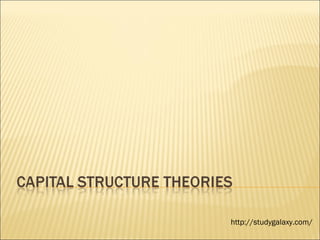
How Capital Structure Impacts Firm Valuation and Cost of Capital
- 2. Capital Structure decision is relevant to the valuation of the firm. In other words, a change in the financial leverage will lead to a corresponding change in the overall cost of capital as well as the total value of the firm. If therefore the degree of financial leverage as measured by the ratio of debt to equity is increased, the WACC will decline, while the value of the firm as well as the market price of share will increase and vice versa.
- 3. First there are no taxes. Second the cost of debt is less than the cost of equity. Third the use of debt does not change the risk perception of investor.
- 4. A company’s expected annual EBIT is Rs. 50000. The company has Rs 2,00,000, 10% debenture. The cost of equity of the company is 12.5%.
- 5. Net Operating Income (EBIT) Rs 50,000 Less: Interest on debentures (I) 20,000 --------------------------- Earnings available to equity holders (NI) 30,000 Equity Capitalization Rate (ke) 0.125 Market Value of Equity (S) = NI/Ke ---------------------------- 2,40,000 Market Value of Debt (B) 2,00,000 Total Value of the firm (S+B) = V ------------------------------ 4,40,000 Overall cost of capital = Ke = EBIT/V (%) 11.36 Alternatively: Ko = Ki (B/V) + Ke (S/V)
- 6. The essence of this approach is that the capital structure decision of a firm is irrelevant. Any change in leverage will not lead to any change in the total value of the firm and the market price of shares as well as the overall cost of capital is independent of the degree of leverage.
- 7. Overall cost of capital is constant Residual value of Equity: Total market value of equity capital = V - B Changes in cost of equity capital: Ke increases with the degree of leveraging.
- 8. A company’s expected annual EBIT is Rs. 50000. The company has Rs 2,00,000, 10% debenture. The cost of equity of the company is 12.5%. Ke = (EBIT – I)/(V – B) = Earning available to equity holders/Total market value of equity shares
- 9. Net Operating Income (EBIT) Rs. 50,000 Overall capitalisation rate (Ko) 0.125 ----------------------------- Total market value of the firm (V) = EBIT/Ko Rs 4,00,000 Total Value of Debt Rs 2,00,000 Total Market Value of Debt (S) = (V – B) Rs 2,00,000
- 10. MM approach support the NOI approach, it means capital structure and cost of capital is irrelevant to value of the firm. Basic Propositions of the MM approach -- The overall cost of capital (ko) and the value of the firm (V) are independent of its capital structure. The total value is given by capitalizing the expected stream of operating earnings at a discount rate appropriate for its risk class. -- Ke increases in a manner to offset exactly the use of a less expensive source of funds represented by debt.
- 11. The MM approach illustrates the arbitrage process with reference to valuation in terms of two firms which are exactly similar in all respects except leverage so that one of them has debt in its capital structure while the other does not. To understand the process let us have an example
- 12. Assume there are two firms, L and U, which are identical in all respects except the firm L has 10% Rs 5,00,000 debentures. The EBIT of both the firms are equal, that is, Rs 1,00,000. The equity capitalization rate (Ke) of firm L is higher (16%) then that of firm U (12.5%). Solution:
- 13. THANK YOU
